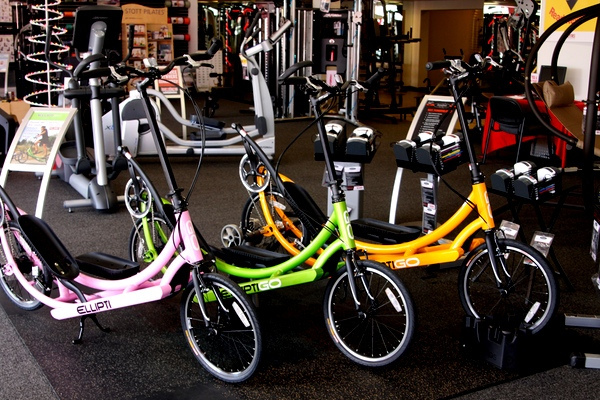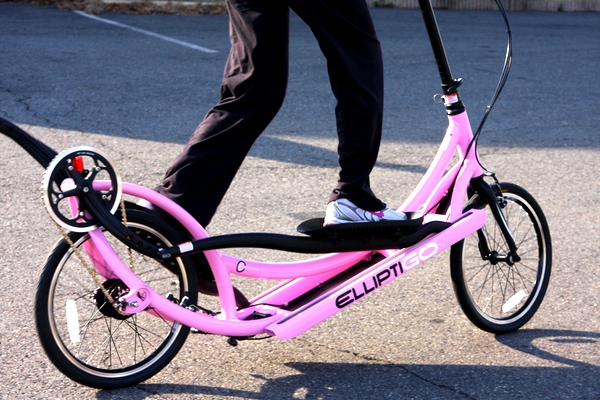The author test-drove an ElliptiGO at Leisure Fitness in Tysons. Photograph by Lauren Migaki
I’ve often thought of ellipticals as the lazy person’s choice of exercise. After all, whenever I still want to feel semi-good about making it to the gym but don’t actually want to “work out,” I opt for a 30-minute session on that very machine.
Then the ElliptiGO came into my life.
The ElliptiGO is an elliptical on wheels, with a handlebar in place of the usual handles that move back and forth as you pedal. I first learned about this funny-looking machine when I watched a video of the first World Championships of Elliptical Biking in November. The participants looked so goofy as they competitively rode these contraptions, but my curiosity was piqued.
I soon realized that the ElliptiGO has been quietly gaining popularity among some big-time athletes since last year, such as “Ultramarathonman” Dean Karnazes and US runner Lauren Fleshman, who called the ElliptiGO the “next best thing to running” in Runner’s World.
The creators, Bryan Pate and Brent Teal, developed the ElliptiGO with injured athletes in mind. Pate’s years of contact sports and Ironman races had taken a toll on his body, and while the elliptical was great for low-impact exercise, he found himself really missing being outdoors. Six years later, the ElliptiGO was born.
“It’s nerd chic,” says local endurance athlete Damon Taaffe. “It’s pretty neat, the looks I get while riding around town. I feel like I’m a tourist attraction.”
The Department of Justice lawyer has been a proud owner of an ElliptiGO for only about six weeks, but has already turned his “easy” seven-mile bike commute from Arlington to DC into a challenging workout on the ElliptiGO.
“The thing that wasn’t obvious to me was exactly how hard the ElliptiGO would be for athletes who take themselves seriously,” Taaffe says. “But even in cool weather, the ElliptiGo makes you sweat.”
Bethesda native Tom Cheplo agrees. The Blank Rome partner has undergone a total of four surgeries on his knees and back and says the ElliptiGO is the perfect (and less painful) substitute to running or biking. He owns nine bikes with his wife, but he now commutes to work in DC on the ElliptiGO at least 80 to 90 percent of the time. “To get the same workout on a bike as running for an hour, I feel like you’d have to be on the bike for four hours,” Cheplo says. “On the ElliptiGO, it’s more like two hours. Plus, there’s no impact.”
So much for being lazy.
Curious, I headed to Leisure Fitness in Tysons, Virginia, one weekend to test it out myself. Since June, the fitness equipment store has sold about 100, according to manager Chip Labbe.
After signing a waiver, I strapped on a helmet and headed out to the hilly parking lot with Labbe, the ElliptiGO rolling along at my side. Labbe adjusted the handlebar to my height and gave me some preliminary instructions as I stepped onto the machine. I felt a jolt of panic right before I pushed off—it felt like I was riding a bike for the first time, without the comfort of training wheels and a seat.
I started downhill and suddenly found myself zooming toward a large parked van. “There are brakes on this thing, you know!” I screamed to myself, finally managing to slow down. It took a while for me to get used to doing sharper curves and going downhill without feeling like I was about to crash into multiple parked cars. I quickly realized it would take more than a test spin to get used to riding an ElliptiGO.
But according to Labbe, I was doing a lot better than most people who have come in to test the product. “There are a couple of battle scars on this one,” he told me, pointing out some scratches on the lime green model he was riding. “One woman couldn’t even go four feet without falling. But she still bought one of these in every color.” (Leisure Fitness currently carries four different hues.)

The ElliptiGO comes in four different colors, including black (not shown here). Photograph by Melissa Romero
The ElliptiGo comes in three different versions: the three-gear, the eight-gear, and the most recent (and expensive) addition, the 11-gear. Labbe says the three-gear is truly just for leisurely rides—it’s quite difficult to go uphill on them—so most customers tend to go for the eight-gear.
None of the models come cheap—the newest 11-gear version tops out at $3,499—but it’s comparable to buying a high-end racing bike or a decent elliptical or treadmill for a home gym. Ellipticals can run from under $2,000 to as much as $4,000, Labbe says. The three-gear ElliptiGO is $1,799 and the eight-gear is $2,399.
The machine is also quite heavy, approximately 44 pounds, which is something to keep in mind if you live in an apartment building with no elevators. Fortunately, you can unhook the handlebar and the front tire if you decide to lock it up outside.
Once you’re over the initial shock of riding an ElliptiGO, you’ll start to notice another perk: The standing aspect allows you to see a lot more on your rides than while seated on a bike. “You can see clearly over the top of cars, and you’re very visible,” Taaffe says. “I do feel quite a bit safer.”
Labbe says it’s a nice detail that may appeal to Delaware and Maryland beach cops, who typically ride bikes on their patrols. Having a better view of one’s surroundings while riding an ElliptiGO may lead to an ideal partnership with the police departments and Leisure Fitness. Plus, the elliptical bike has already turned heads among police officers.
Labbe was testing out the ElliptiGO for the first time, sans helmet, when a cop pulled him over.
You’ve got to be kidding me, he thought. But the cop only wanted to know, “What the heck is that?”
For more information, visit the Leisure Fitness Web site and elliptiGO.com.


















